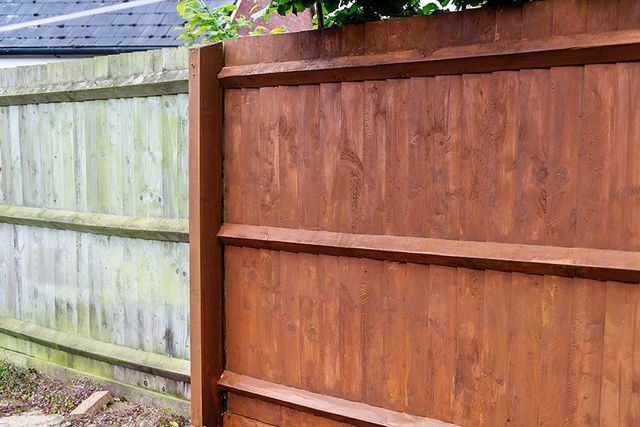Raise Your Deck's Look with Deck Staining Franklin
Raise Your Deck's Look with Deck Staining Franklin
Blog Article
Important Tips for Deck Discoloration Success
Attaining a flawlessly stained deck requires even more than just a brush and a canister of stain. From selecting the ideal type of stain to grasping the art of application, each phase plays a vital role in the final outcome.
Choosing the Right Spot
Picking the suitable tarnish is critical in accomplishing a resilient and aesthetically pleasing surface for your deck. deck staining near me. When picking a discolor for your deck, it is necessary to consider variables such as the wood kind, wanted shade, level of security required, and upkeep choices
To start with, consider the sort of timber your deck is made from, as various timber species may react in a different way to specific sorts of discolorations. Woods like oak or mahogany may call for various stains contrasted to softwoods like want or cedar. Comprehending the characteristics of the wood will aid you choose a stain that passes through effectively and enhances its natural charm.
Next, think of the color you desire for your deck. Stains can be found in a variety of hues, from all-natural tones that improve the timber's grain to even more opaque shades that give better UV security. Select a shade that matches your outdoor area and matches your visual preferences.
Furthermore, examine the degree of security the stain offers. Some discolorations offer a lot more comprehensive protection against UV rays, dampness, and mold, which can lengthen the life of your deck. Balancing protection with visual appeals is key to achieving a durable and visually appealing surface.
Preparing the Deck Surface
To guarantee an effective application of the chosen stain, detailed prep work of the deck surface area is vital. Utilize a deck cleaner or timber brightener along with a stiff-bristled brush to scrub the surface clean.
Replace or repair these as needed to make sure the structural integrity of the deck. This step not just aids the stain adhere much better but also improves the general look of the deck.
Using the Stain Appropriately

Begin by completely mixing the stain to make certain an also consistency. Use a paint stirrer to blend the discolor well, especially if it has been resting for a while. When applying the tarnish, use a sprayer, paintbrush, or roller , depending on the sort of tarnish and the size of the deck. Job in manageable areas to stop the discolor from drying unevenly. Apply the discolor towards the wood grain to make sure also coverage and a professional finish.
Permit the first layer to completely dry entirely prior to making a decision if a second coat is necessary. Adhere to the producer's directions pertaining to drying times and reapplication. Proper application of the stain is essential for shielding your deck and boosting its appearance for many years ahead.
Maintaining Your Stained Deck
After successfully applying the stain to your deck, maintaining its appearance and safety high qualities is essential for long-term resilience and aesthetic allure. Regular upkeep is key to preserving the beauty and honesty of your discolored deck. deck staining near me To maintain your deck looking its finest, it is recommended to cleanse it a minimum of yearly. Use a moderate cleaning agent and water to eliminate dirt, gunk, and mildew that can accumulate externally. In addition, inspect your deck every year for any type of signs of wear or damages. Dealing with concerns quickly can avoid them from worsening and extend the life of your tarnished deck. Relying on the foot traffic and direct exposure to the elements, you may need to reapply a fresh layer of discolor every 2-4 years. This will certainly aid maintain the shade and safety surface of your deck, making sure that it remains to improve your outside room for many years ahead.

Troubleshooting Common Issues
Recognizing and addressing usual problems that might develop with your tarnished deck is vital for ensuring its durability and optimum efficiency. One typical problem is flaking or peeling of the tarnish.
One more issue usually experienced is mold and mold growth on the deck surface. This can be credited to moisture retention, absence of sunlight, or improper ventilation. To tackle this issue, an extensive cleansing with a mold and mold remover followed by correct drying out and application of a mold-resistant tarnish is vital.
Furthermore, fading of the stain shade gradually is a widespread concern. UV exposure and harsh weather condition can create staining. To resolve this, selecting a high-grade, UV-resistant stain and applying a fresh coat periodically can aid keep the deck's aesthetic charm.

Final Thought
Finally, successful deck discoloration needs picking the best tarnish, properly preparing the deck surface area, using the stain appropriately, and keeping the discolored deck. By adhering to these necessary suggestions, you can achieve a beautifully discolored deck that enhances the total look of your outdoor area. Keep in mind to troubleshoot any kind of usual concerns that might occur during the staining process to make sure a durable and aesthetically appealing outcome.
Attaining a faultlessly stained deck requires more than just a brush and a container of stain.To guarantee an effective application of the chosen discolor, complete preparation of the deck surface area is essential. When using the discolor, use a sprayer, roller, or paintbrush, depending on the type of stain and the dimension of the deck.Determining and resolving usual issues that may emerge with your tarnished deck is vital for guaranteeing its durability and optimal efficiency.In conclusion, successful deck staining requires picking the right stain, effectively preparing the deck surface, using the tarnish appropriately, and keeping the discolored deck.
Report this page